Last Chance to Catch NYC's Holiday Notalgia Train
We met the voices of the NYC subway on our nostalgia ride this weekend!



One of the mansions along Brooklyn Avenue in Crown Heights. Corner of Dean Street.
Crown Heights, Brooklyn has long been on the list of up and coming neighborhoods and as the pace of new construction and renovation attests, this reputation is not going away any time soon. The traditionally West Indian and Jewish neighborhood has been seeing an influx of urban up and comers, seeking neighborhood authenticity and affordable prices.
Located northeast of Prospect Park, Crown Heights is roughly bounded by Atlantic Avenue on the north, Washington Avenue on the west, Empire Boulevard on the south, and East New York Avenue on the east. Eastern Parkway serves as a divider between north and south Crown Heights.
As historian Francis Morrone writes in his book An Architectural Guide to Brooklyn, the origin of the name “Crown Heights” is a little murky “but we are certain it had nothing to do with English royalty.” Nevertheless its brownstone lined streets and stately standalone mansions make its architectural legacy in league with the other “heights” of New York City, Brooklyn Heights and Clinton Hill, as an “elevated abode for the affluent,” continues Morrone. But in many ways, Crown Heights has even more to offer with its eclectic history and urban fabric.

One of the beer tunnels, kept in close to original condition for events
Just next door to the popular beer hall Berg’n in Crown Heights, cheese is aging dozens of feet underground inside 1850s-era lagering tunnels under the former Nassau Brewery. Opened in 2014, Crown Finish Caves is a licensed New York State dairy plant aging cheeses from places near and far. There are cheeses from the Hudson Valley, Vermont, Maine, Wisconsin, even Italy. Crown Finish Caves ages the cheeses using the process of affinage.
See photographs of the cheese aging in action here, inside of the retrofitted beer tunnels.
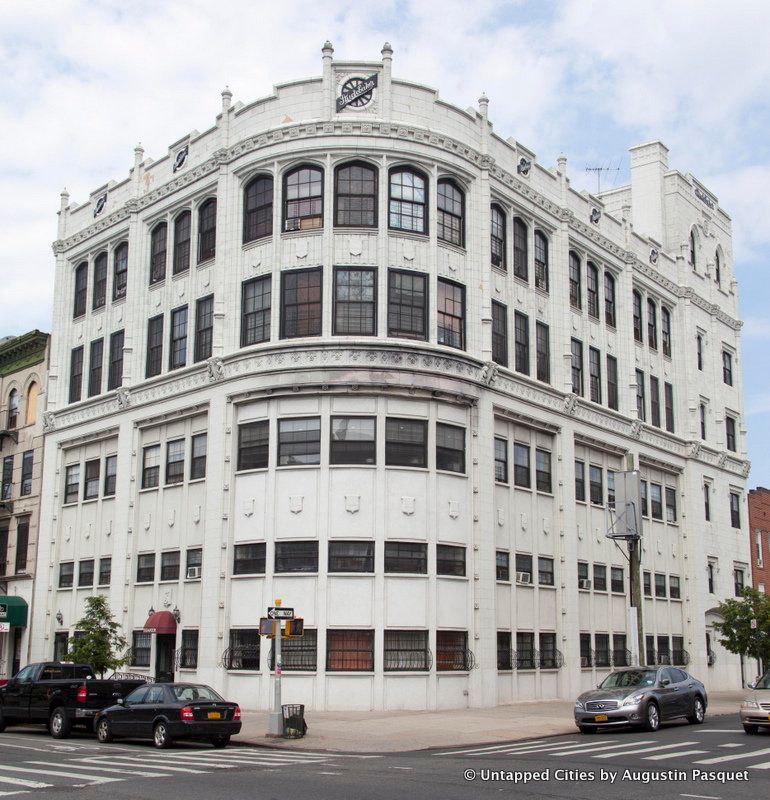
By the early 1900s, Brooklyn was bustling and its wealthy residents were participating with equal fervor in the automobile craze as their Manhattan counterparts. Much of the automobile industry was clustered in Crown Heights. Although there remains a clustering of auto repair shops in Crown Heights, it is far from how Brooklyn’s Automobile Row felt in its heyday, when the major automobile brands – Ford, Chrysler, Buick, General Motors, Pontiac – were sold in dealerships and showrooms along Bedford Avenue, with service centers and garages rounding out the auto-related offerings.
Notable spots south of Eastern Parkway include the Firestone service station on Empire Boulevard, with a fantastic Art Deco-era overhang, and the Simons Motor Sales Co. repair shop at 1590 Bedford Avenue across from the Bedford-Union Armory. But the Studebaker Building on Bedford and Sterling is the gem of Automobile Row. The landmarked building was built in a neo-Gothic style out of concrete and brick, with a white terra cotta facade. Along the parapets at the top of the building you can still find the wheel logo of the Studebaker company. The front facade, which once had large windows to showcase cars, has been altered significantly and the building was converted into apartments for low-income, disabled and homeless families.
Another fun historical jaunt is to trace the remnants of Ebbets Field, the Dodgers stadium that once stood in south Crown Heights.

Marker Coffee on Rogers Avenue, in south Crown Heights may be tiny but it has a super friendly staff and delectable selection of handmade cookies baked in house – offerings include lemon shortbread, chocolate chip, ginger molasses, oatmeal cranberry raisin and toffee. Marker also carries homemade chocolate bars. Cafe Grumpy coffee is served and on the non-coffee end, there’s quite a plethora to satisfy non coffee drinkers too with hot chocolate, hot cider, teas and other specialty drinks. There are three stools at the front window and a little seating outside, plus free WiFi.
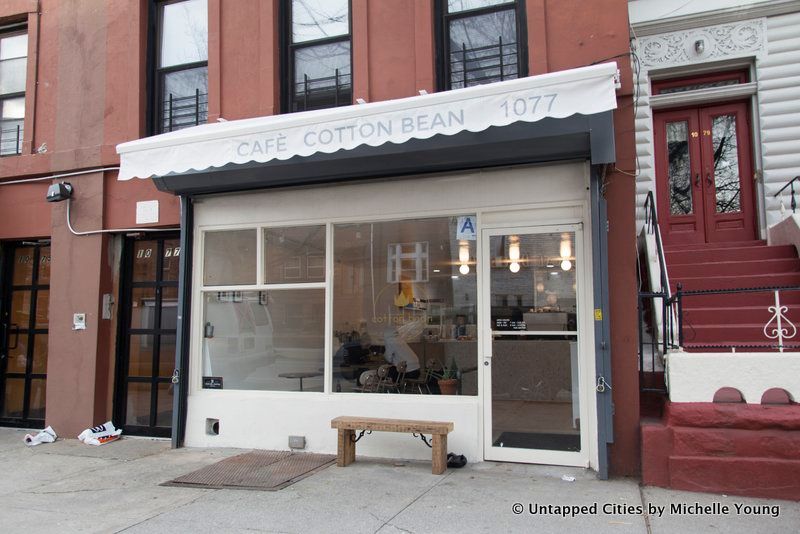
Cafe Cotton Bean is one of the latest to arrive in Crown Heights, and the Japanese coffee shop hits all the right notes. The minimalist decor may look more like a store from the outside, but inside you can get an equally reassuring focused offering of pastries, sandwiches and drinks, including Parlor coffee, amidst a soothing space. Cafe Cotton Bean might be a little pricier than its neighbors for the basic cup of coffee, but there’s something nice about a simple menu of great products. The menu is made of vinyl letters on the wall (what a brilliant idea – makes it easy to update and revise the menu). The pastel formica school chairs and wooden floorboards offer a retro, Americana feel.
The solid offering of coffee shops in Crown Heights makes it hard to choose. Some of our other favorites include Tinto’s (doubles as a brunch spot: get the cast iron baked eggs or the mozzarepa. Also carries Blue Marble Ice Cream); Colina Cuervo, and Manhattanville Coffee. And of course, Little Zelda by neighborhood small business entrepreneur Michael de Zaya is really the forerunner of all of these newcomers and has a cozy, old European feel.

The Weeksville Heritage Center is another must-visit in Crown Heights, further off the main drags. Weeksville is one of the country’s first free black communities formed before the Civil War and is said to have been an important stop on the Underground Railroad. The center has historic homes and a cultural buildings, and has an ongoing diverse events series that includes performances, talks, youth volunteer initiatives, and gardening. Every second Saturday, visits to Weeksville are free which includes screenings of a documentary about Weeksville and tours inside the historic Hunterfly Road Houses.

There’s an urban surprise tucked away on the second floor of the Brooklyn Children’s Museum in Crown Heights, as interesting for adults like us as it is for piquing the curiosity of our city’s children. Alphabet City, an installation of black vinyl by Elizabeth Hamby on the walls of this level of the museum, shows the footprints of 61 NYCHA public housing developments in New York City. By placing them all together in this way and in the abstract, the viewer truly gets the sense of how affordable housing architecture has permeated our collective understanding of urban design.
The museum, designed by architect Rafael Viñoly (more famous today for the 57th Street skyscraper 432 Park, is a modern spot in an otherwise historical section of Crown Heights.
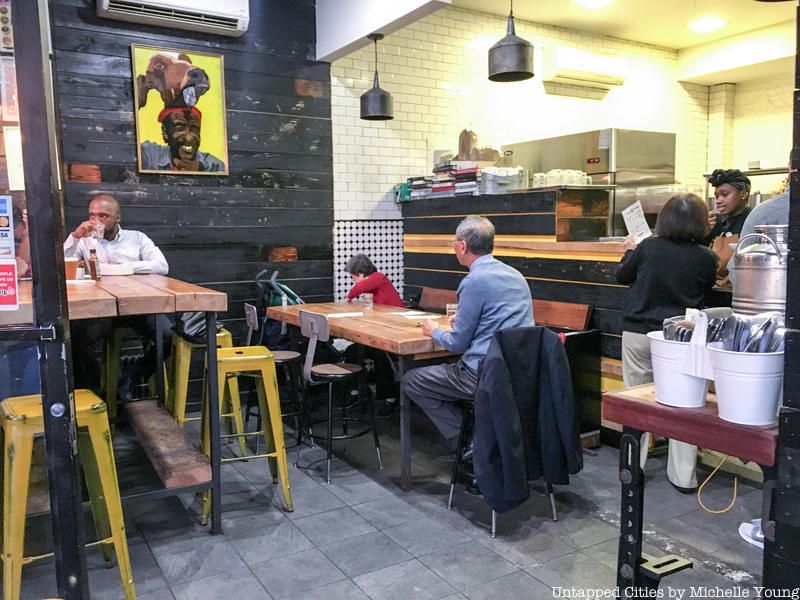
The Food Sermon takes the Caribbean and West Indies heritage of Crown Heights into the new century, with a modern offering of “Island Bowls” packed with flavor. In 2015, the New York Times pronounced the arrival of the Food Sermon in almost blessed terms: “…the Food Sermon, standing on a corner with its windows shining and its name in letters as yellow as the noon sun, may be mistaken at first for a sleeker, more modern place of worship. Perhaps that’s no mistake, if you consider food a matter urgent for the soul.” The Food Sermon was one of the early newcomers to this stretch of Rogers Avenue in south Crown Heights that includes indie movie theater Video Revival, Marker Coffee, and the bar Branch OFC.
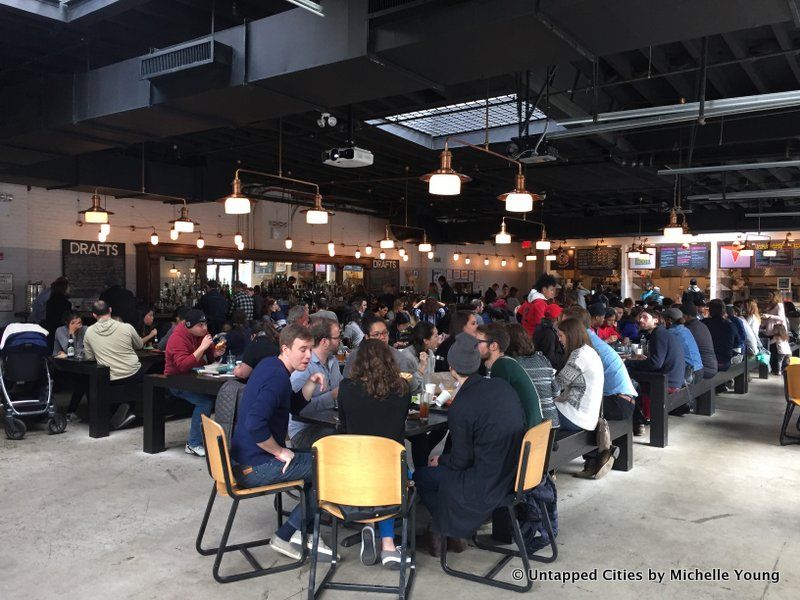
Berg’n beer hall at 1000 Dean Street has a rotating cast of food vendors that make it an ideal spot for brunch on its long, communal tables. Currently, you can find Mighty Quinn’s BBQ, Lumpia Shack, Dub Pies and Landhaus. Berg’n is the brainchild of Jonathan Butler, who also founded the Brooklyn Flea and Smorgasburg and runs office space in 1000 Dean Street, the former Studebaker Service Station.
And of course, don’t miss the many Jamaican shops around Crown Heights. Gloria’s is the most famous, thanks to an Anthony Bourdain visit (the original location is in south Crown Heights, but a newer location is on Nostrand Avenue and Sterling Place). Peppa’s Jerk Chicken is a solid newcomer, and we’re hoping that Papa’s “hole in the wall” will open up shop again soon.

Video Revival is an art house movie theater inside a former beauty salon on Rogers Avenue. When it first opened, it was truly quite hidden but it has since opened up its storefront and removed the original blue awning. Video Revival had a simple impetus – a movie theater closer to the area where the founders, Christian Hendricks, Erik Escobar and Hollis Johnson, live where they can revel in and share their penchant for indie, art house films. The auditorium style chairs inside come from a church in Philadelphia, found on Craigslist. The team drove down to get it in a Uhaul, picked the chairs up disassembled and reassembled everything in Crown Heights.
See more photos of Video Revival here.

Nowhere Studios, the former office of Untapped Cities, is a wonderfully communal co-working space on Atlantic Avenue. Husband and wife Porter and Sarah Fox run the space (and Nowhere Magazine) in a former garage, where they also built all the furniture inside and atop on the rooftop deck, where the members are also growing vegetables and herbs. A resident cat, Mister Miyagi, who was abandoned on the front doorstep and subsequently adopted, is the true manager of the office. Nowhere Studios hosts public workshops and events.
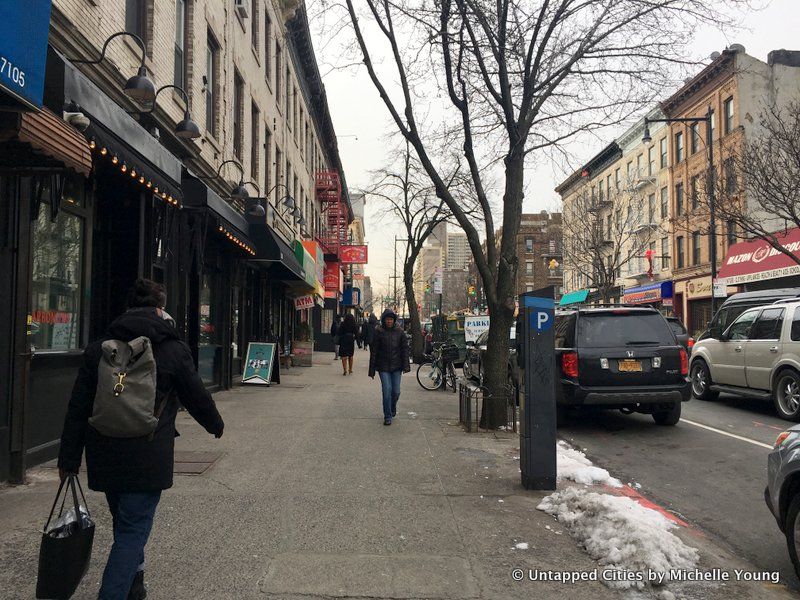
You’ve probably been wondering when Franklin Avenue was going to come into play in this guide. Franklin Avenue is the main hotspot of the new Crown Heights, packed with restaurants like Mayfield, Barboncino (voted best pizza in Brooklyn), Chavela’s, The Crabby Shack, Bunsmith, Domo Taco, Gladys, and Brooklyn Winery‘s outpost BKW. With some great bars, it has the vibe of Bedford Avenue in Williamsburg before it became luxury-fied.

In the midst of the street grid in Crown Heights is an odd diagonal midblock street known as Clove Road. Located behind an A&P supermarket, it’s so forgotten the Google Street View car didn’t even bother to turn down it. Yet, it may have one of the richest and longest histories of any street in the neighborhood.
Clove Road is what remains of a Native American trail and later Colonial era road and it retains some of its old Belgian blocks to boot. (Belgian block, rectangular pieces of granite that came from ship ballast, is commonly miswritten as cobblestone but the two are actually different.) Architect Michael Cetera, who has studied Clove Road in depth, says it was also an important location in the American Revolutionary War and was one of the first roads in Brooklyn to be paved. It was also possibly a portion of, or nearby, the Bedford Pass, which allowed passage through a ridge that is today’s Eastern Parkway. American troops used this pass to retreat back to Brooklyn Heights during the Battle of Brooklyn.

We just love this oasis in the middle of Crown Heights. The Miami-esque vibe of King Tai, named after the Chinese restaurant that previously occupied the building, is truly unexpected on this stretch of Nostrand Avenue. All cocktails are $10 and the menu shows icons of the type of glass the drink comes in. Round bar stools circle the curved bar and pastel colors abound. Food and wine also served.

This watering hole always does the trick. In the summers at Franklin Park, the former driveway is transformed into a cozy open air beer hall with picnic tables. In the winter, head inside for two brick-lined spaces (in a former garage) with a fireplace and classic games like Big Buck Hunter and air hockey. You can enter on St. John’s Place or through Dutch Boy Burger, also run by Franklin Park owners Matthew Roff and Anatoly Dubinsky.
Branch OFC was founded by a former bartender at Franklin Park. The cocktail bar, located on Rogers Avenue south of Eastern Parkway, seems to take its design cues from the nondescript Italian social clubs in Brooklyn with its high front walls on the outside, a retro look on the inside with checkered vinyl floors and a vintage cash register. Cocktails are $11, beer, wine, snacks and sandwiches are also served. Monday nights are movie nights.
What would you add to this guide? Next, check out our guide to 15 must visit spots in Astoria, Queens.
Subscribe to our newsletter